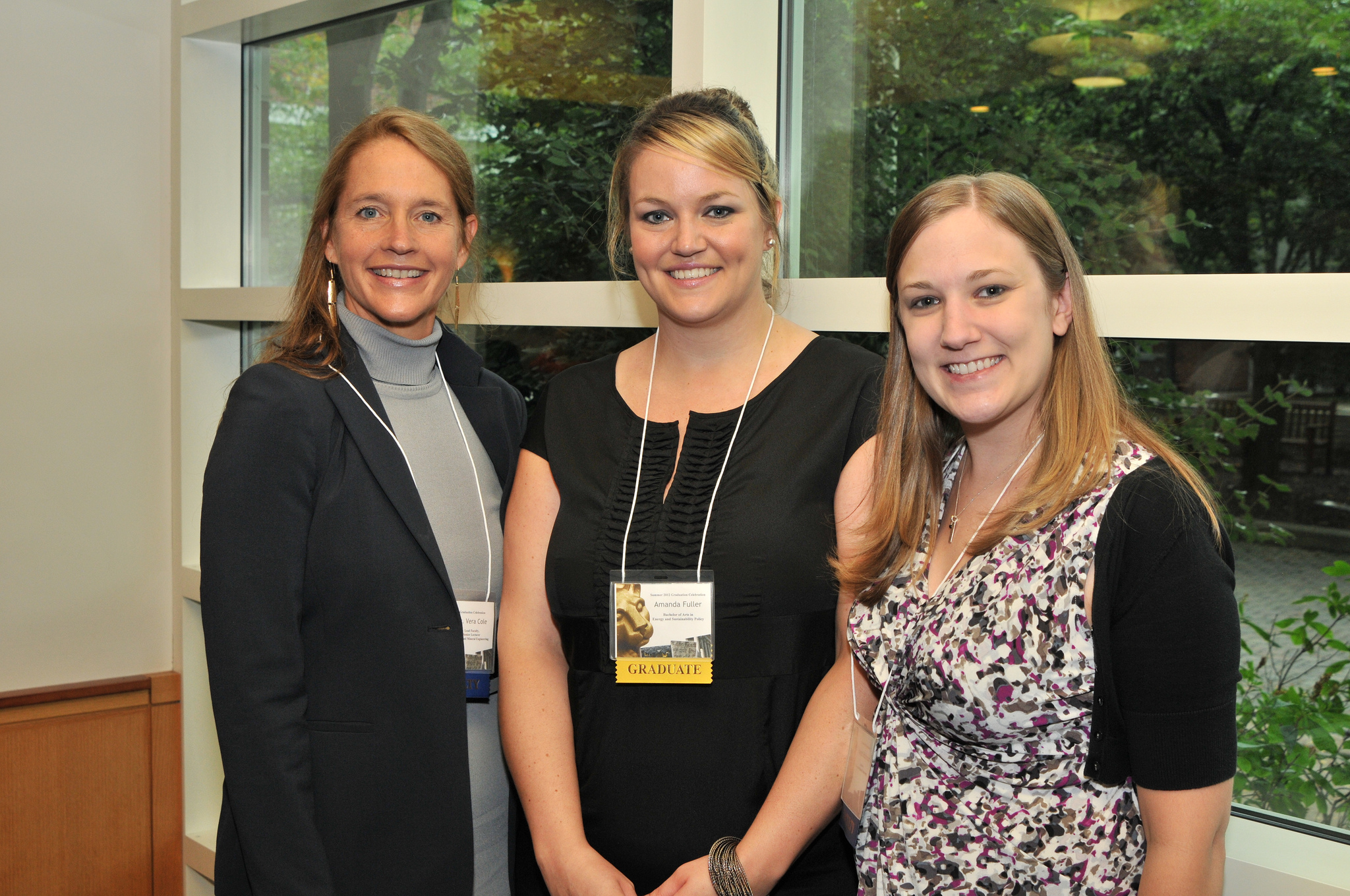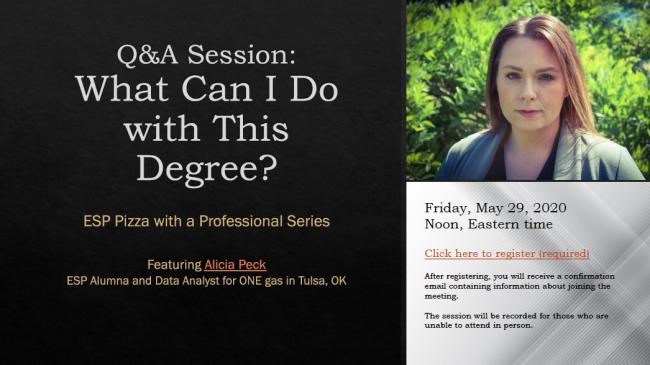
ESP Students Partner with Centre Regional Planning Agency
For her spring semester course GEOG 432: Energy Policy, Brandi Robinson, Assistant Teaching Professor in the Energy and Sustainability Policy (ESP) program, was looking to offer her students an assignment with real-world applicability. Partnering with Pam Adams, Sustainability Planner with the Centre Regional Planning Agency, proved a way to give students a unique opportunity.
Throughout the spring 2021 semester, Energy Policy students conducted research, presented their findings (via Zoom) and were able to inform the development of the Centre Region’s Climate Action and Adaptation Plan, which will impact the six municipalities in the Centre Region – the area immediately surrounding University Park, Penn State’s main campus.
Alex Swithers, a senior working toward his BS in ESP, appreciated Robinson’s effort. “Instead of regurgitating course information to maximize rubric points, [this project allowed] for creative thinking, where we put ourselves in the target community [and] … determin[ed] a viable solution,” he said.
Sydney Hines, also a senior in the ESP program, agreed. “Projects with real-world applicability… [give students] more incentive to learn and care,” she said.
Energy Policy looks closely at the implications of policy decisions related to energy and climate. In support of local climate initiatives, students provided Adams and the Centre Region Council of Governments with executive summaries of best practices from communities across the country and focused on four areas: electric vehicles, municipal energy management plans, residential solar installation, and energy efficiency programs.
Students looked at key dimensions of each of these areas, including incentive programs, education and outreach initiatives and monitoring and tracking strategies. The goal was to create a summary of lessons learned and to provide recommendations for how the Centre Region might choose to proceed in these areas.
Joyce Arpon, now an alum of the ESP program, was determined to provide Adams with relevant information and ideas that could be implemented in the Centre Region. She worked diligently to craft good questions, fill out information request forms, and make electronic and telephone connections with municipal officers in Albuquerque, New Mexico and Garfield County, Colorado, which Arpon targeted specifically because of the applicability and transparency of programs in those localities.
Arpon cited a key benefit of the project to be “learning about a variety of programs and seeing what others are doing.” “There aren’t any journal articles about communities these sizes,” she said, recognizing that her determination to make connections allowed her to gain unique insight into obscure programs such as an initiative in Colorado where locals, and not traditional experts, were recruited to educate and encourage their peers in the community to adopt sustainable practices.
“Students put forth tremendous effort because they understood and were motivated by the fact that this assignment had real-world applicability,” said Robinson. The benefit to the Centre Regional Planning Agency was summed up by Adams: “The students’ research provided proven strategies and identified actions that are critical for [success] as well as [those to be avoided]. I was impressed with [the] reach of their findings and with their terrific examples of successful community programs.”
ESP graduate completes program requirements while helping his home Parish plan for the future
ESP student Jude Graham fulfilled his internship requirement by working with the City of Gonzales to complete a Greenhouse Gas Emissions Inventory for the community. He then completed a Climate Action Plan for his capstone project in EME 466. Click this link to read about Jude's work and how it helped the Parish recently adopt a resolution including ambitious emissions reduction targets through 2050.
Energy and sustainability policy student balances education, disaster response
Click on the image above to watch the recording of the event (37 minutes).
Congratulations to ESP graduates!
The Energy and Sustainability Policy graduating class of December 2020!
E - John De Montfort
S - Robert Deutsch
P - Lucas Skiba
2 - Christen Goeken
0 - Ronnie Gomes
2 - Jon Kearney
0 - Nikki Kline
(not pictured, Kenn Fowler)
With this group, we cross the line of having more than 100 graduates of the major since it began in 2010! We're excited to see all the great things these newly minted graduates go on to do with their hard-earned degrees.
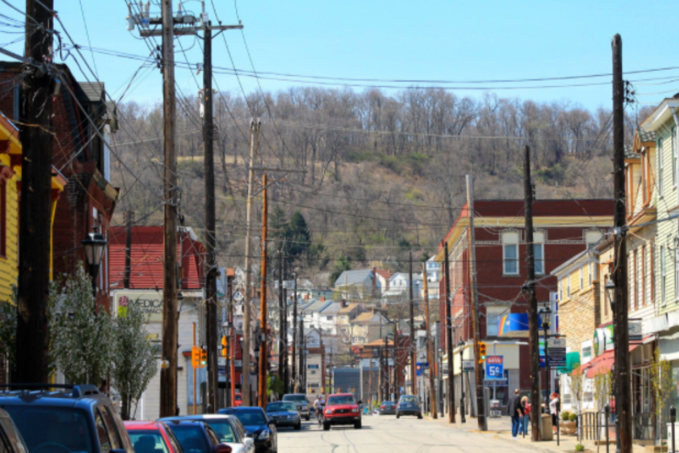
Click here to learn more about the project.
Recent Pizza with a Professional Series Recordings
Click the image below to watch the recording (35 min.) of the information session with Mark Fedkin from November 13, 2020. The presentation begins at the 6 minute mark.
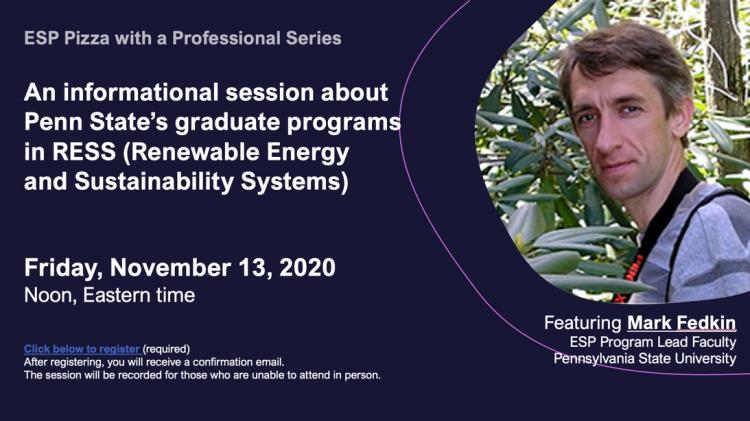
Click the image below to watch the recording (51 min.) of the Q&A Session with Jennifer Williams from October 9, 2020
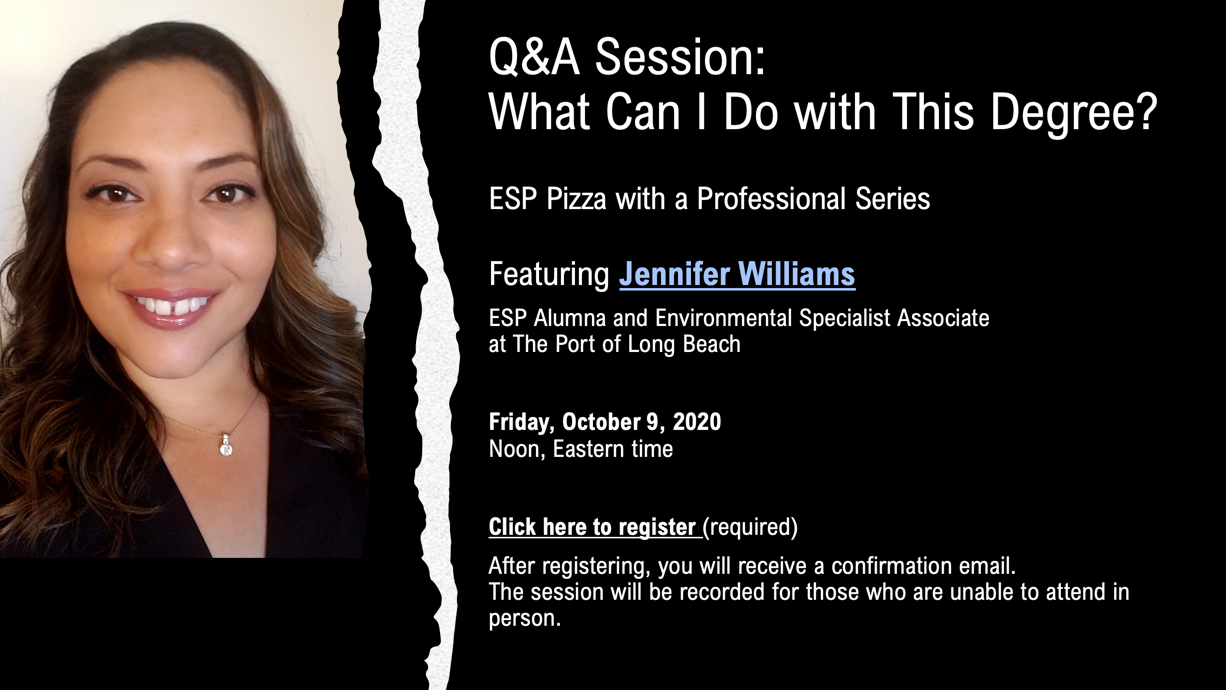
Click the image below to watch the recording (1hr. 21 min.) of the Q&A Session with Alicia Peck from May 29, 2020
Congratulations, Graduates!
On-campus graduation wasn’t possible this spring, but we’re incredibly proud of our 2020 graduates, our largest graduating class to date.
These graduates are off to undertake new adventures and join fellow ESP alums in making the world a better place!
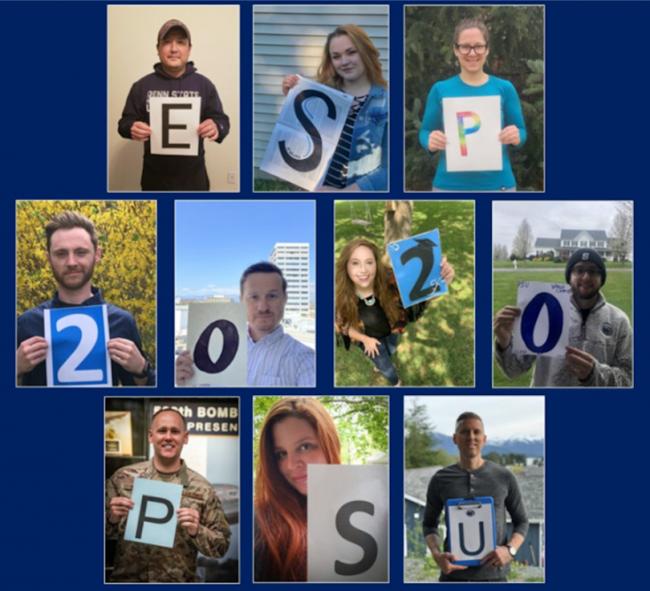
May, 2020 ESP graduates Chris Stephens and Alex Riedel submitted beautiful artifacts to share the reflective thinking surrounding their capstone projects. Congratulations to all of our 2020 graduates!
This is a story about a Penn State Energy & Sustainability Policy student....and his ever-evolving sustainability worldview.
My name is Christopher Stephens. This is my story.
Part 1: My Sustainability Worldview.
I learned early on that it's important to invest the time and energy and resources into the things you really care about. For me, I care about being a responsible steward for the environment. And so I shaped my disposition, values, knowledge, and skills around sustainable concepts like preserving nature, minimizing my carbon footprint, and advocating for causes that I believe are right. I believe that a part of learning, though, is shaking your core beliefs a little. I entered the ESP program with a foundation of knowledge and a beneficial outlook, and yet I still experienced moments where my beliefs were shaken and I felt challenged. I'm thinking of one example during this class, actually. I was scanning the Principles of the Earth charter. One of the principles, respect and care for the community of life, gave me pause. How do you even operationalize this tenet? Even with my perspective, I found it challenging. How do you take that concept and apply it to an integrated, long-term solution for the future? I simply realized I have so much more to learn.
Part 2: Demonstrating Sustainable Concepts.
Taking the concepts that I've learned in the ESP program that shaped my thinking allowed me to research an issue that I found important to my community -- chronic homelessness. As I worked with community partners around Los Angeles to find adaptation solutions, I started to feel personal agency towards addressing the very real and relatable issue of homelessness.
Part 3: Looking to 3 U.N. Sustainable Development Goals for Guidance.
SDG #1: No Poverty.
There was no more important SDG during the preparation of my capstone project than to end poverty in Los Angeles. I worked with my community partner to develop adaptation measures and policy considerations that didn't simply throw money at the problem and hope for a quick fix.
SDG #3: Good Health and Wellbeing.
During the course of this class, I also thought that the SDG for good health and wellbeing was equally important as no poverty in Los Angeles. And that's because the project construction from many of Los Angeles's urban development projects will create large amounts of particulate matter in the downtown Los Angeles area.
SDG #11: Sustainable Cities and Communities was a critical component for me to learn more about this semester, and there are two Los Angeles urban development plans currently under way. Both projects are billion dollar projects but don't address the displacement of over 50,000 homeless people in downtown. Displacement of these individuals moves them further away from the community-based organizations and essential services designed to help them.
Part 4: A Revised Sustainability Worldview.
Earlier, I mentioned that my thinking has evolved when it comes to ESP principles. I will also continue to learn more and grow in this field. I'm fortunate enough to be able to apply my learned ESP experience to my career. I work for a Community Choice Aggregator that buys 100% renewable energy on behalf of the communities that it serves. I can't just walk away from what I've learned in the ESP program; I have to continually learn and apply so much more about operationalizing California's efforts to create a more sustainable and verdant world for future generations.
ESP Connections & Conclusions.
As this presentation comes to a close, I want to share with you three decision-making questions that I have learned from my time in the ESP program. I ask myself these questions on an almost daily basis. The first question that I ask myself is, "What is the impact of doing or buying this?" And of course, the next questions that kind of dovetails with that is, "Do I really need to do this or buy this right now?" And, if absolutely necessary, "What are the negative consequences, if any, of doing this thing or buying this thing?" When I think about whether or not my worldview has evolved dramatically, I think about my perspective and how it shapes my decision making, but the ESP program has empowered me to make conscious decisions that provide sustainable solutions. These decisions are really shaping who I am as a responsible steward of the environment and a human being.
Thank you!

Sustainable Stealth: Strategies for Immplementing Energy & Sustainability Policy at a Missori Air Force Base
By Alexander Riedel
Community Partners: Glenn Golson, Environmental Program Manager, John Allen, Energy Manager, and Andrea Goodson, Chief, Asset Optimization
Executive Summary
U.S. Air Force installations are important power projection platforms. Nowhere is this truer than at Whiteman Air Force Base, the nation’s only home of the B-2 Spirit nuclear-capable stealth bomber. Enduring military installations in the continental U.S. and overseas are also part of their surrounding communities and operate similarly to small towns, cities and college campuses.
This case study examined existing energy & sustainability applications at Whiteman Air Force Base with consideration to current plans and attempted to identify potential program improvements and efficiencies. The research and interviews conducted for this capstone project resulted in the proposal of a Strategic Sustainability Flight Plan to address the energy source-based efficiency and emission reductions possible by utilizing various small-scale, sustained environmental program efforts, behavior adaptations and a renewed communication leadership role at Whiteman AFB.
Project Review: How I Approached It
As a Public Affairs Airman, I have always been surprised by the absence of a cohesive narrative for sustainability at my home installations. Through this capstone, I was able to work with the civil engineers responsible for the environmental management system on base to examine how the installation approaches overall environmental protection, energy efficiency and sustainability policy in daily practice.
I conducted research via a literature review on existing federal mandates, scholarly analysis, military net-zero energy/waste installation case studies and examined potential program applicability at Whiteman AFB. I further analyzed the results of past energy feasibility studies, conducted various stakeholder interviews and performed several site visits to our base recycling center, waste water treatment facility, heat steam plant and civil engineering center.
I then began my review and analysis and developed summary recommendations for future objectives, tools and approaches for sustainable developmenet at WAFB. The results of my capstone will be used to create a local communication plan that will shape our installation's online community engagement presence, public accountability reporting and demand reduction/behavior awareness campaigns.
How it Challenged My Thinking
While I am familiar with the regulatory environment of Air Force Squadrons and Wings as a service member in the public affairs field, my research has greatly amplified my experience and understanding of the current dynamics in the Air Force energy/environmental program structure. I learned that the primary drivers that motivate environmental action within the DoD are mission-driven performance incentives and compliance with laws and regulations.
I was suprised to learn that my installation simply does not have a sustainability plan; this, to me, was a glaring omission and missed opportunity. While very skilled engineers worked diligently to improve base load and energy intensity, leadership support for a cohesive vision was lacking. While enterprise level guidance exists, along with case studies from the corporate world, such guidances are surprisingly not implemented locally. Despite this disappointment, I quickly grew interested in the processes and methods for compiling a sustainability plan/report and the overall importance of a multi-disciplinary plan to gain leadership support and overcome system inertia toward policy implementation. I was able to synthesize my professional experience with ESP coursework and draft strategies for creating environmental action by leveraging communication tools to create bottom-up awareness. Based on my research, I recommended various proven strategies that are mirrored at University campuses and increasingly at U.S. military installations, to include: establishment of a multi-functional sustainability task force with the goal of establishing a cohesive sustainability vision, metrics and plans; regular emissions and energy performance inventories to track the success of programs; and strong support for employee/service member and community engagement that strengthens understanding and support for sustainability efforts base wide.
What I Learned
I began this project as a an insider to the 509th Bomb Wing, my home unit, but an outsider to the environmental management and energy programs of our civil engineering unit. The program allowed me close access to our asset management and energy experts. This gave me crucial insights into program management limitations, such as funding, but also enabled me to pinpoint opportunities for strategic improvements to the status quo of the installation programs. Furthermore, it allowed me to create important groundwork for partnerships that will pave the way for future cooperation. This existing experience will provide me with the knowledge and know-how necessary for me to advocate more effectively for a sustainability programs at WAFB - beginning with public communications.
I learned that effective communication with stakeholders and internal program managers is crucial in de-conflicting interests and focus areas. Many military leaders are not focused on sustainability because regulations and mandates have never sufficiently challenged them to do so. This will inevitably change as the understanding of climate change as a threat to national security and mission readiness increases.
I initially approached this program as a research thesis, which unfortunately cost valuable time. If given the opportunity, I would focus much more strongly on the real-world applicability of the behavior-oriented stakeholder communication program. For instance, we have little to no recycling presence in many buildings and our public reporting is minimal - even when there are good news to report. All this distracts from focusing attention on the important programs contributing to overall installation sustainability.
I also learned to analyze data and represent findings visually in order to communicate crucial details and opportunities that otherwise may be lost to the casual reader/observer.
Moving forward, I will use the existing plan to draft a new sustainability program website, draft a new communication plan for stakeholder enagement and make recommendations toward a "Leadership & Environmental Action Flight" volunteer group to foster environmental stewardship and training among Airmen.

On April 28, 2020, Penn State’s Faculty Senate passed a Climate Action Resolution that was put forth by Brandi Robinson, Faculty Senator and Assistant Teaching Professor in the ESP Program.
The passing of the resolution means that the Faculty Senate will request that university leadership develop a Climate Action & Adaptation Plan to strive to achieve “100% reduction in purchased electricity-generated GHG emissions by 2030” and that the university will reduce by 100% or more, by 2050, net GHG emissions “through direct mitigation activities, carbon sequestration, and offsetting opportunities.” The resolution includes language for an increase in investment in solutions initiatives and for an increase in the identification of “courses of action to reduce the impacts of and [to] embrace the opportunities created by anthropogenic climate change.”
Congratulations, Brandi!
Robinson, B. (2020). Faculty Senate Climate Action Resolution. Penn State University Faculty Senate website.
December, 2019 graduate and Pennsylvania resident Kelli DeThomas recently earned her BS in ESP. While a part of the program, she made great use of her time journeying with the GREEN Program to Iceland. An engaging narrative and photos reside on the blog she created for the experience.

Kelli wasn't always a gung-ho Penn Stater. She says, refering to the photo below, "My aunt bought me that outfit, and then the rest of my life I vowed never to go to Penn State. So we all had a good laugh about that... ."
Congratulations to Kelli and to all of our 2019 graduates!

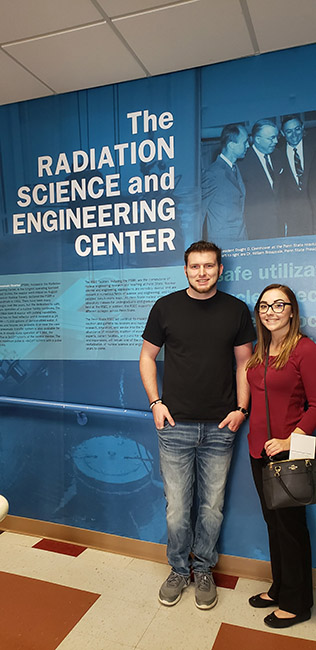
ESPBS students Ashley Ubil and Charles Jones recently met face to face during a tour of the Breazeale Nuclear Reactor at Penn State’s University Park campus. Ubil, of Washington state, was taking a tour to learn about the reactor, and Jones has been an intern at the facility for several years.
The Breazeale Nuclear Reactor, the oldest continuously-operating reactor in the United States, “went critical” in August of 1955. This was just following President Dwight Eisenhower’s forward-thinking “Atoms for Peace” speech, which sought to bring nuclear energy and science into public discussion and to be used for peaceful endeavors. Penn State, at the time led by Milton Eisenhower (brother of the U.S. president), soon established its own research reactor and has ever since maintained it as a facility for education, outreach, research, and service.
To learn more about Penn State’s nuclear reactor, read “Nuclear Options: Breazeale Nuclear Reactor Puts Atomic Science to Work for Research.”
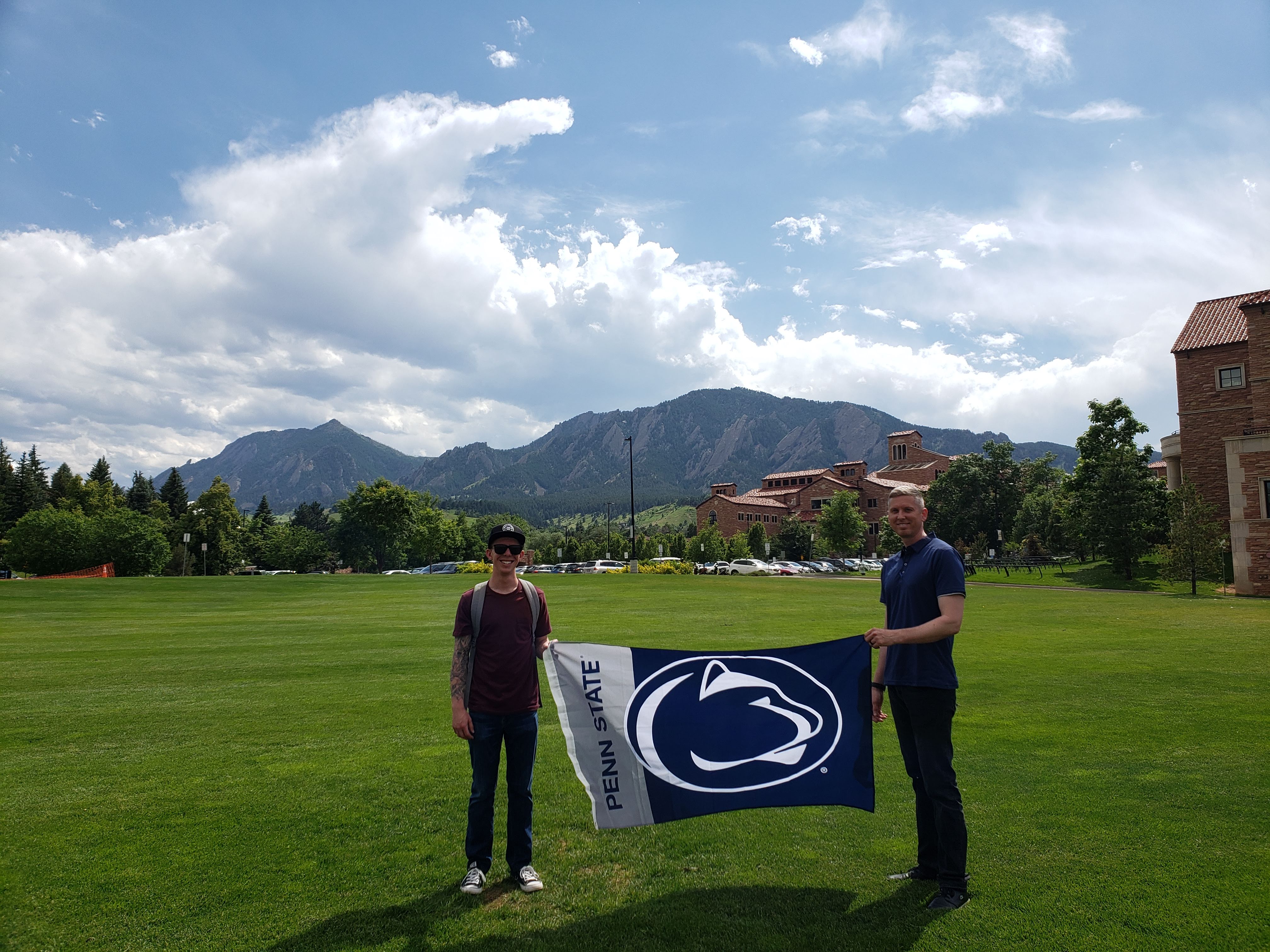
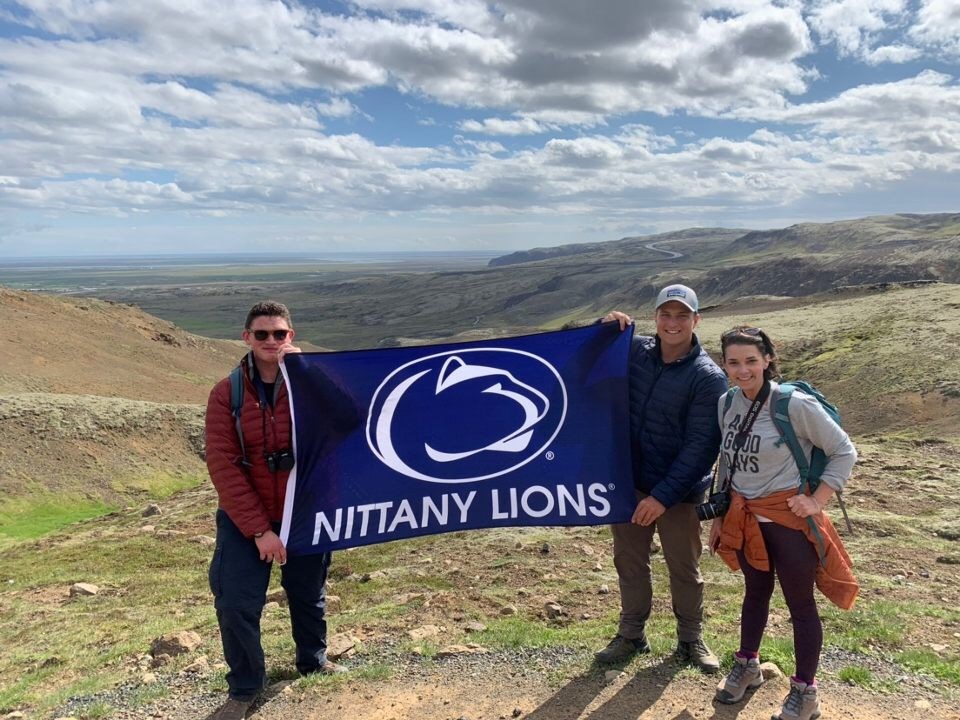
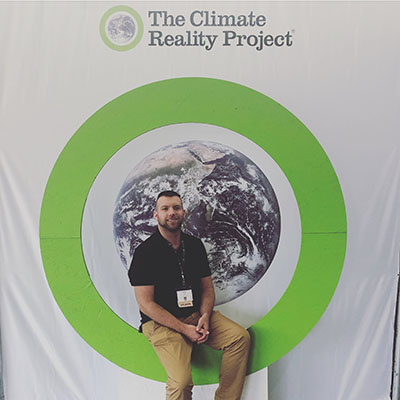
Sean Gray has always counted Al Gore as one of his heroes. So for Gray, a student in the Energy and Sustainability Policy program, three days of training led by the former vice president could not have been more exciting. Gray attended The Climate Reality Leadership Corps’ training in Atlanta, Georgia, which he found to be “one of the most influential and memorable experiences of [his] life.”
Over three days, this intensive training paired climate activists and social justice leaders to explore the intersection between climate crisis and equitable solutions, and focused on building a coalition dedicated to climate justice and thriving communities. Educational sessions were balanced with those dedicated to public speaking, media engagement strategies, and grassroots organizing.
For attendees like Gray, the skill-building and networking went hand in hand. “I was able to gain valuable contact information and to launch the organization of a local climate reality chapter in southwest Florida,” he said, and noted that the experience strengthened his resolve: “This conference reminded me that I am not alone in this fight to make the planet a better place.”
For information about The Climate Reality Leadership Corps and their upcoming trainings, visit the Climate Reality Project website.
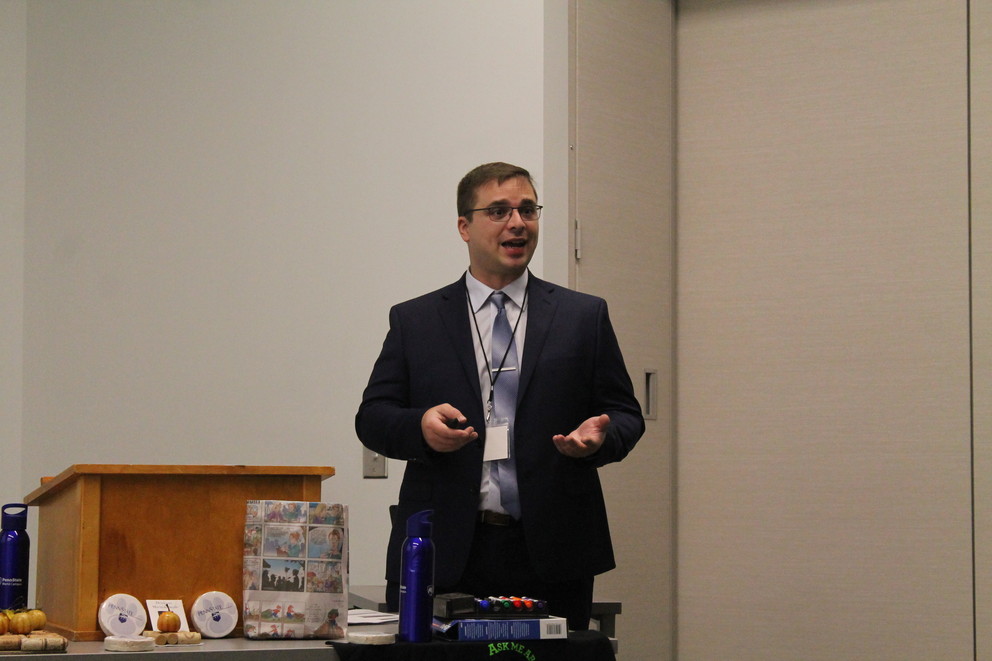
Penn State’s World Campus is widely acknowledged to offer students a world-class education. Perhaps less well-recognized is that it can offer students a rich student life experience, too.
READ MORE about the second anniversary of the World Campus Sustainability Club.
UNIVERSITY PARK, Pa. — A new program aims to reduce the number of plastic bags used at the Penn State Bookstore. The program, called EcoCoin, will launch initially on the University Park campus this summer. The program is supported by the Penn State Bookstore, Sustainability Institute, and University Park Undergraduate Association (UPUA).
READ MORE about why ESP student, Sam Anawalt launched the EcoCoin initiative.
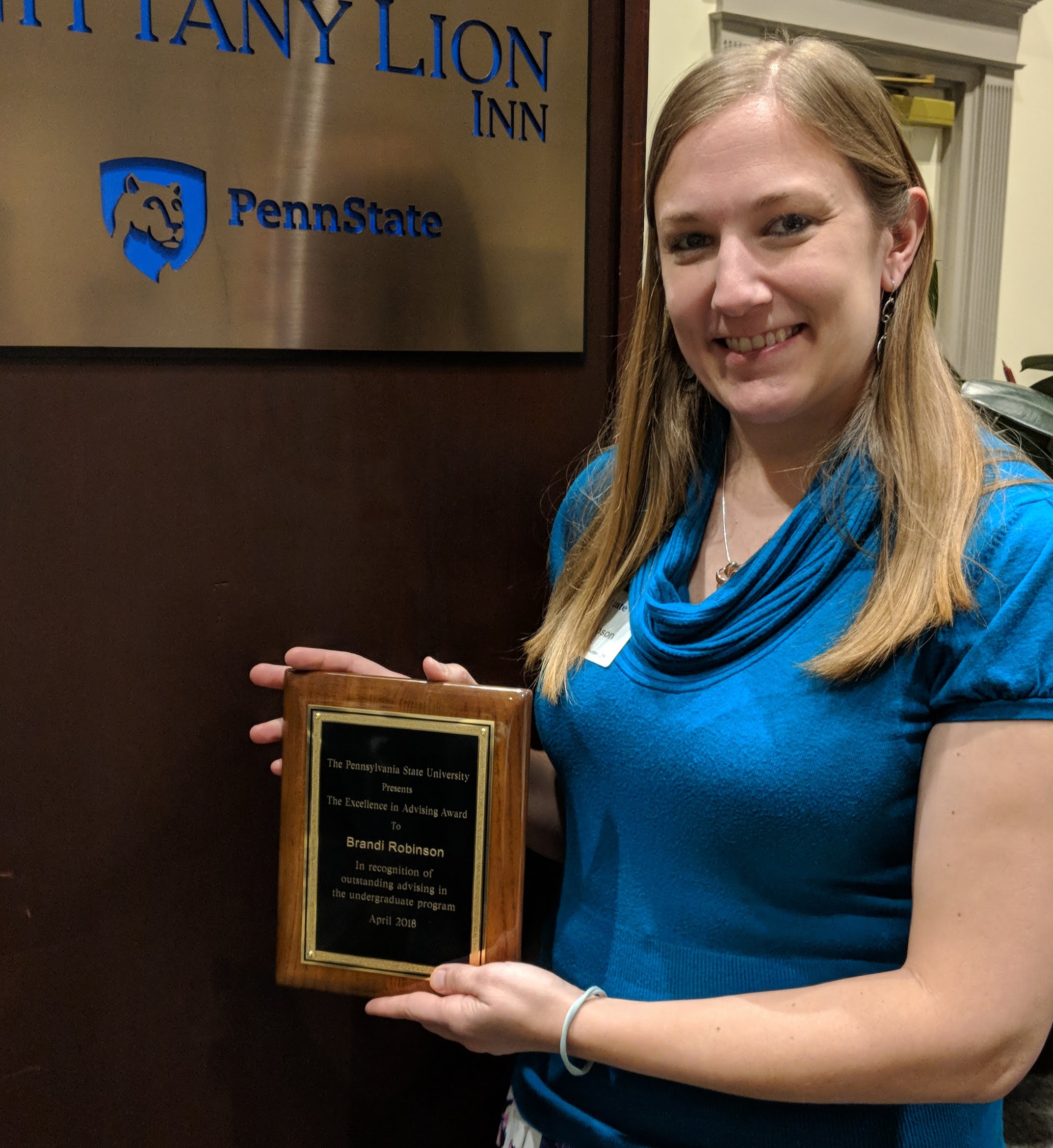
UNIVERSITY PARK, Pa. — Rebekka Kuhn, academic adviser in the Division of Undergraduate Studies, and Brandi Robinson, faculty adviser for the Energy and Sustainability Policy program in the John and Willie Leone Family Department of Energy and Mineral Engineering, have been selected to receive the 2018 Penn State Excellence in Advising Award.
Read the Faculty Focus Blog that also featured Brandi
Alumni Spotlight: Amanda Fuller
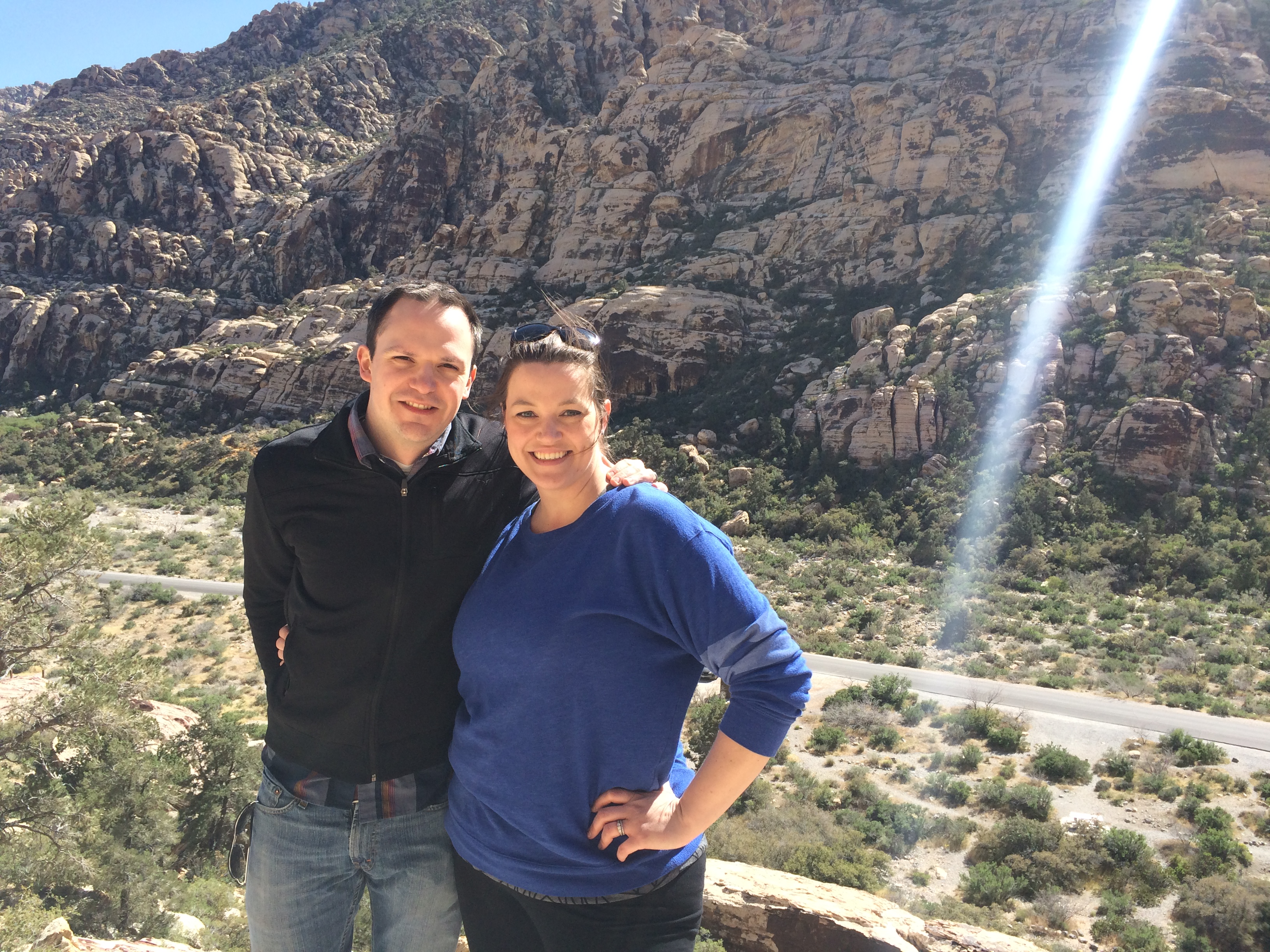
Mandy Fuller began working for ICF as an Energy Efficiency Program Consultant in August of 2012, after graduating with a BA in ESP. Today, she’s still with the company, and enjoys being part of a team that works to be a positive impact on the communities they serve.
When graduation drew near for Mandy, she jumped into job searching full throttle, “I was checking multiple sites almost daily for positions in sustainability or energy-related work. I used mainstream sites like Indeed.com, green job specific sites, and frequently checked for job postings on the websites of particular organizations.” Her hard work and dedication paid off when she found the position at ICF.
As an Energy Efficiency Program Consultant, Mandy manages the behavioral energy programs for a utility. She evaluates the client’s needs regarding marketing, customer service, and data and budgetary issues. “I also work with the ICF team to continually improve our behavioral program offerings and design.” In addition, Mandy is a member of a team that works to develop new programs based on the newest technologies and trends and then works with clients to bring those ideas to fruition. “I work with a team of other energy efficiency program managers from varied backgrounds. The diversity in experience makes collaboration much more interesting.“
“The best part of this job is working for a company with varied areas of expertise.” In addition to their commercial energy division, ICF also has contracts in defense, public health, climate change, and education domains. Mandy really feels that the diversity of work encourages outside of the box thinking, saying “It’s great to be able to use colleagues as resources!”
Mandy feels that many of her ESP courses prepared her for professional success at ICF. The policy making and evaluation-focused courses as well as the writing and speaking courses were particularly valuable. “Professional writing & public speaking is scary for almost everyone - we can all benefit from extra practice in these areas!”
Mandy appreciates the flexibility her full time position at ICF affords her. “I’m able to set a schedule that works with my carpool, family commitments, or other challenges. I’m also able to telecommute two to three days a week.” The ability to contribute to meaningful work while still taking care of other responsibilities is a priceless perk to the job that Mandy already loves.
Mandy’s advice to current ESP students: “Be patient. Some markets are less progressive than others in terms of energy policy, making jobs fewer and farther between. Once you find something, don’t be afraid to take chances and jump on opportunities. The more you learn, the more valuable you become as an employee and a citizen.”
You can connect with ESP alumni like Mandy by joining the ESP LinkedIn group called “Penn State ESP Majors and Alumni”.
Faculty Spotlight
UNIVERSITY PARK, Pa. — Vera Cole, energy and sustainability policy program chair, was awarded the Epstein Lifetime Achievement Award for her roles with Penn State’s energy and sustainability policy online programs offered through Penn State’s World Campus and with the Mid-Atlantic Renewable Energy Association. Read the full Article
Student Spotlight
UNIVERSITY PARK, Pa. — For nearly four decades, Christine Stallard has dreamed about getting a bachelor’s degree. Now, in her 60s, Stallard finally fulfilled that dream. In May 2017, she graduated from the online Energy Sustainability and Policy program, offered through Penn State World Campus and the College of Earth and Mineral Sciences. The program not only allowed her to fulfill her dream but it also allowed her to share her wealth of knowledge about the electricity industry with classmates. Read the entire article here.

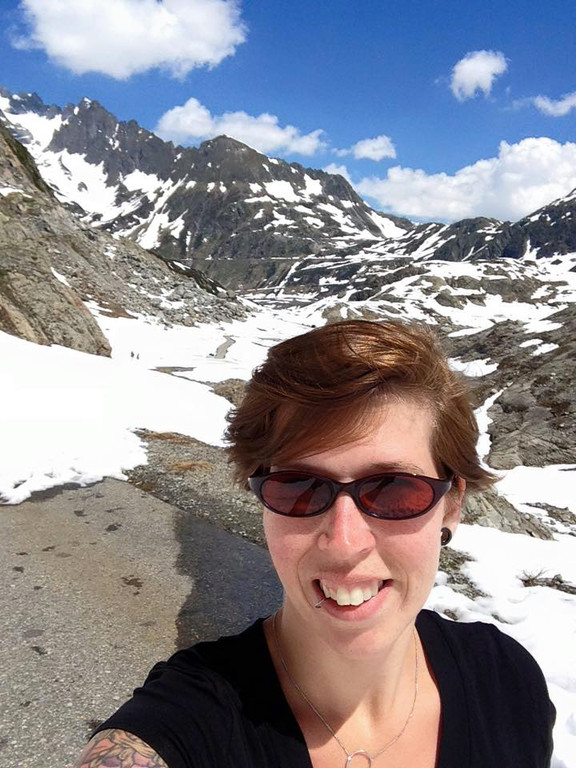
UNIVERSITY PARK, Pa. — Meg Wieger finished high school early to pursue her dream of becoming a country music singer. Now, she’s pursuing another dream: earning a college degree and beginning a career in the renewable energy industry. Recently, she visited Ireland to fulfill the study abroad component to her energy and sustainability policy major at Penn State’s World Campus. Read the entire article here.
Alumni Spotlight
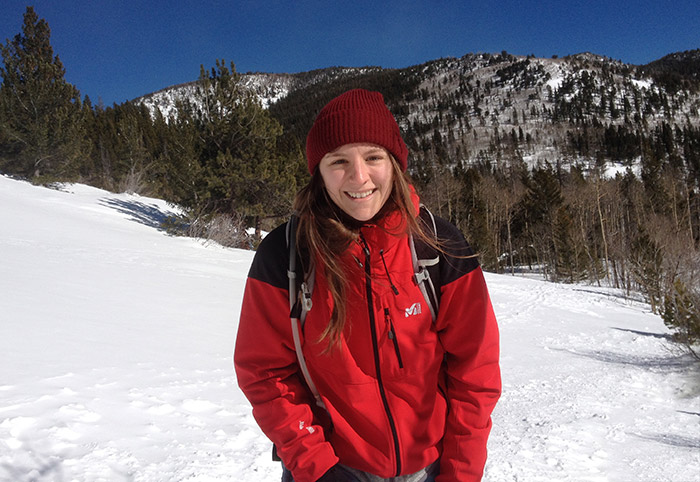
While an ESP student, Marielle Martin completed degree requirements from her home in Palmyra, Pennsylvania. Nowadays Marielle can now be found in Denver, Colorado, working as a Senior Photovoltaic Site Modeler for Sunrun Inc.
After graduation in December 2015, Marielle scoured the job ads, focusing on opportunities in the renewable energy field. After applying for a position as an Energy Adviser with Sunrun, Marielle was contacted and asked if she’d be interested in interviewing for a Photovoltaic Site Modeling position instead. She agreed, and now Marielle works on a Site Modeling team with 16 other people in Sunrun’s Design Engineering Department.
Sunrun currently operates in 14 states and seeks to “provide planet-changing home solar in a simple, inexpensive, low-risk way.” They provide customized solar systems, designed and installed to fit “customer’s homes, lifestyles and savings goals.” Sunrun uses a trademarked technology that enables them to design a system using basic information and satellite imagery of customer’s homes. They also offer payment plans that make solar installation more accessible to a broader range of people. (Sunrun, 2017)
The Site Modeling Team at Sunrun is responsible for creating digital models of potential customers’ homes and surrounding property, and then generating preliminary solar system design options. Marielle’s primary responsibilities include the creation and maintenance of a reference guide that contains the process and reference materials needed for each potential project site. She spends the majority of her days updating content and fielding questions, while also communicating and coordinating processes with Design Engineers.
The reference guide Marielle created allows the Site Modeling team to easily access important regulations and requirement information based on the project’s location. For example, each “Authority Having Jurisdiction” or AHJ (e.g. villages, municipalities, cities, boroughs, etc.) maintains different regulations regarding roof setbacks (the distance that solar panels need to be from the side and top edges of a roof). Marielle’s reference database makes this type of information easily accessible to the Site Modeling team. For the Modelers, it’s critically important to be able to access quickly the local AHJ’s regulations when designing potential systems. Since Sunrun works in multiple states, and with multiple sales partners and installation branches, it is imperative that each of the variables are taken into consideration when modeling each site.
February 1, 2017 was Marielle’s one year anniversary working with Sunrun. Marielle is happy with her position and says she enjoys the variety that the position offers and the people she gets to work with. “I get to work on different projects and tasks every day… it’s the enjoyable work environment that really seals the deal.” In addition to the reference guide, Marielle also provides quality review for the Site Modeling team, and updates Sunrun’s internal website content. She also serves as a leader on the company’s Engagement Team, organizing things like Lunch & Learns, volunteer opportunities, and social activities.
Experiences gained while a student in the ESP program have helped Marielle be successful in her current position. “The simple necessity of learning to communicate effectively through technology is critical to my job. I also use general policy concepts like SWOT analysis to compare potential tools, resources, and process changes. In a more technical sense, understanding energy concepts (power, energy, efficiency, etc) is important when talking with sales representatives.” Marielle credits courses like EGEE 102, EME 444, EGEE 401, EGEE 495 and GEOG 432 with providing her with a solid foundational knowledge in energy and solar concepts and an understanding of the potential future of energy. However, she states that the Capstone course, “EME 466, may have been most important to my position, which taught me to how to prepare and present an idea. I use this skill whenever I modify or write a new process, or present an up training session.”
In her last year as an ESP student, Marielle interned at EcoStrategies, LLC in South Burlington, VT. During her internship she worked on several projects including the Capital Commuters Program, the Go Vermont initiative, and worked with the Vermont Energy & Climate Action Network. While interning she attended multiple outreach events and created various materials to communicate effective strategies to help commuters conserve resources and increase energy efficiency.
When asked if she could give fellow ESP students some helpful advice as they enter the job market, Marielle responded, “The jobs are out there!” She also added that distinguishing yourself is a great idea, suggesting that students near graduation, “take NABCEP training, strive to be an EMSAGE Laureate, or get LEED certified!”
You can meet ESP alumni, such as Marielle by joining the ESP LinkedIn group called “Penn State ESP Majors and Alumni”.
Written by: Haley Sankey
February 3, 2017
Student Spotlight

UNIVERSITY PARK, Pa. — Choosing to finish a degree through Penn State World Campus was easy for Tip Stama, but he still faced hurdles during his educational journey. In August, after taking a hiatus from his studies, Stama will graduate with a 4.0 grade-point average and a bachelor of arts in energy and sustainability policy (ESP), an online College of Earth and Mineral Sciences program. He will represent his graduating class as college marshal and is the second ESP graduate selected for this honor. Unlike most students who start working full time after graduating, Stama began his career as an environmental compliance specialist in May. Read the entire article.
Student Spotlight

Mike Reichart, an energy and sustainability policy student, is one of the first people in the world to receive professional certification through the International Society of Sustainability Professionals. Read the entire article
ESP students attend EnergyPath
back row (l-r) Mark Moore, Kelli Gohn, me, Brian Hillard, Mark Mulhollem
Recently the Sustainable Energy Fund held the 2015 EnergyPath Expo at University of Scranton. Eight Energy and Sustainability Policy students attended. Six of which participated in Dr. Vera Cole's solar boot camp and two others attended one of the other bootcamps offered.
There are full scholarships available to students, so check out the website and be sure to put it on your calendar for next year. The Expo and Bootcamps will be held at the Penn State University Park campus in 2016.
More ESP Graduates!
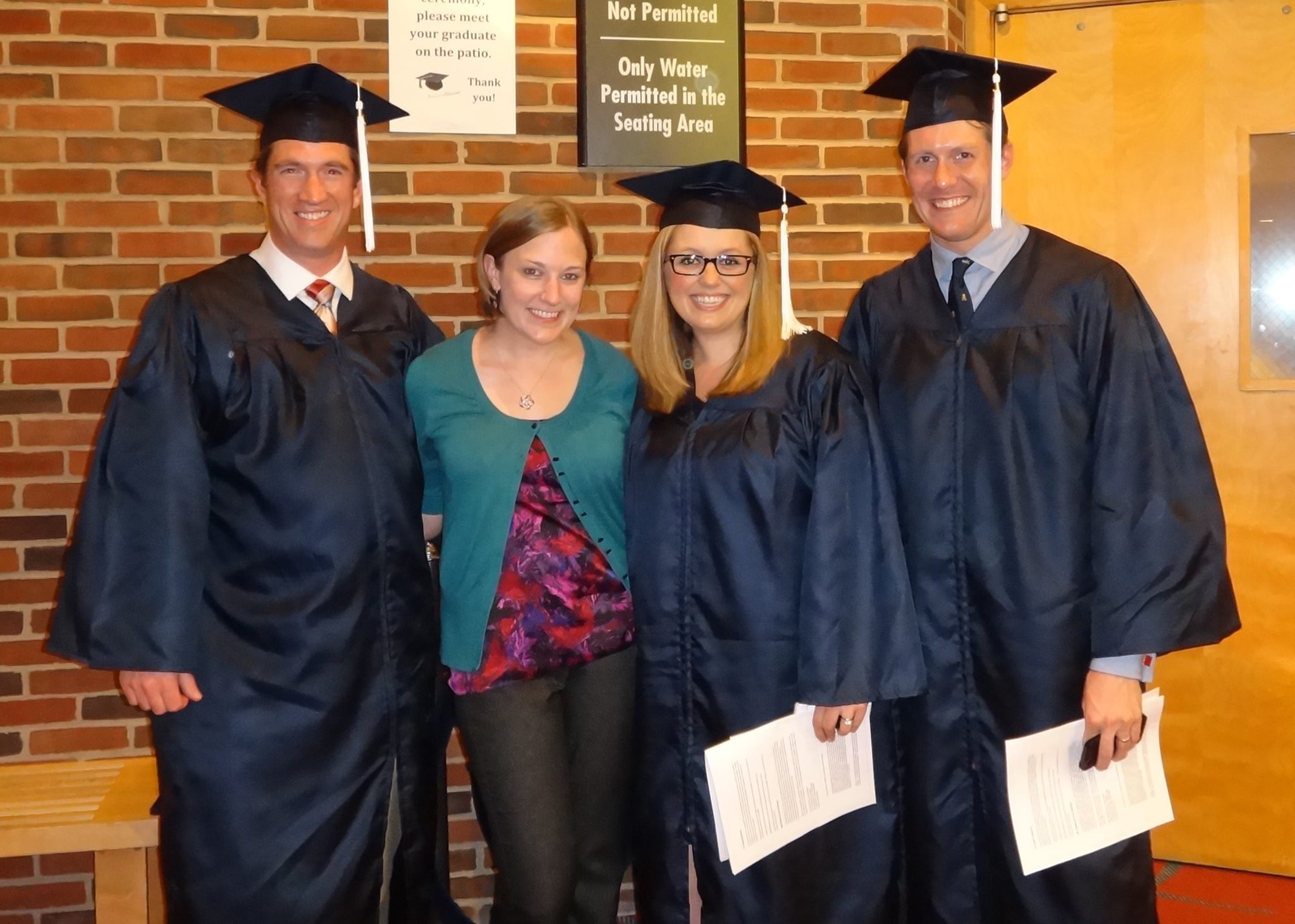
Over the weekend the ESP program celebrated three graduates: Geoffry Soura, Mark Staub and Vanessa White. All three were able to attend graduation and take part in the World Campus reception. ESP faculty member Brandi Robinson was able to attend the ceremonies and celebrate our graduates' accomplishments! Congrats to our graduates!!
Study Abroad or Intern?
You can read about the experiences of our ESP students who completed their internship and study abroad experiences in the Summer 2012 semester.
Learn more about Justin Polosky's internship experience by checking out his blog.
First ESP Graduates
Over the weekend the ESP program celebrated its first graduates; Todd Venetz and Amanda Fuller. Mandy was able to attend graduation and take part in the World Campus reception where she got to meet other World Campus students and ESP faculty members Brandi Robinson and Dr. Vera Cole. Another ESP student, Rory Spangler, walked in Commencement and hopes to complete his degree requirements this fall. The photos below were provided by Brandi Robinson.
You can visit Penn State Live to read the press release about these first ESP graduates!
